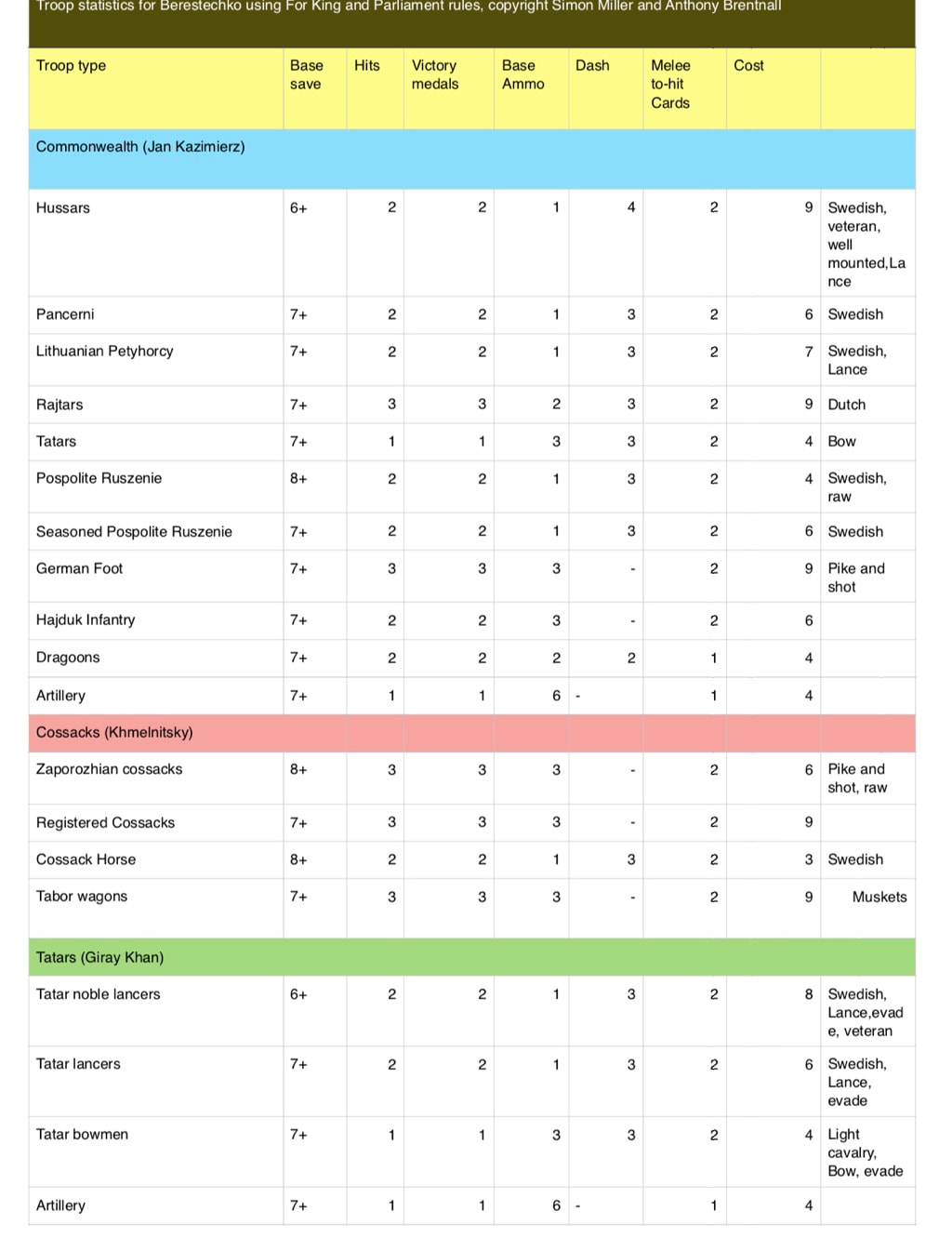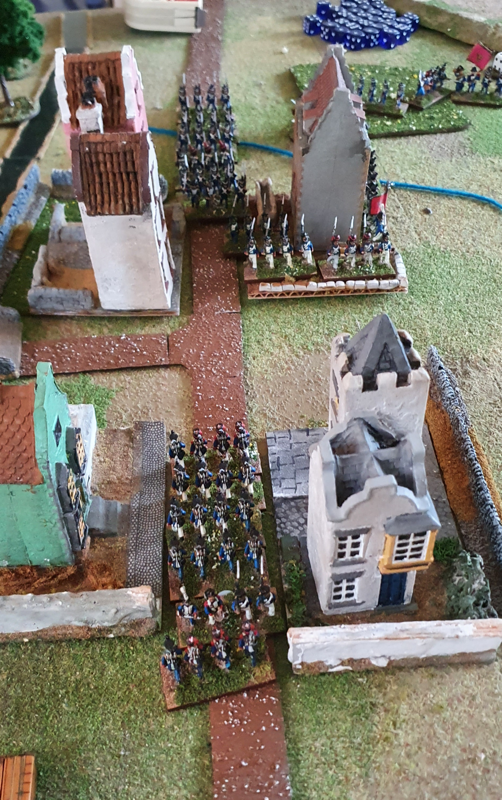|
I have set out to adapt Andrew Brentnall and Simon Miller’s ECW rules, ‘For King and Parliament ‘, to cover Eastern Europe and specifically, the Battle of Berestechko, 30 June 1651. Although some east European troop types are not covered by these rules, most of them are either directly covered or can be represented by equivalent unit stats. The myth seems to linger (in Western Europe that is) that warfare in the East was more ‘primitive’ than in the West, with armies full of lassoo-wielding savages on steppe ponies. It’s true that some specific troop types existed and that in general, the cavalry arm was a bigger proportion of eastern armies than in the West. But most of the troop types present in the Commonwealth armies of the 1650s would be recognisable in a west European force (indeed, many of the troops were recruited from Western Europe) and in wargaming terms, the mechanics and many unit stats in For King and Parliament are applicable with little or no adjustment. The following are my first thoughts about adapting the rules to the East. I will revisit them after a few games. Commonwealth troops Hussars count as well-mounted, veteran Swedish-style Horse, armed with a lance (conferring a one-off extra to-hit card). This is fitting, given that Gustavus Adolphus had based his new cavalry tactics on those of his fast-charging Polish opponents. Pancerni count as seasoned Swedish-style horse. Petyhorcy count the same, with an added lance. Reiters could be Dutch, or increasingly Swedish as the century progressed. As accounts of Berestechko describe the Reiters as providing fire support in the Centre rather than in the cavalry wings, I am inclined to make them still Dutch in 1651. ‘German’ foot are standard pike and shot units at a 1:2 ratio. Haiduk infantry have the same stats as commanded shot. These troops operated in smaller units than German foot so the original stats can stand. Most were seasoned troops. Dragoons also read across directly, although the Commonwealth used them in great numbers and they were among the most hard-worked troops in the borderlands given their ability to keep up with the cavalry. Some dragoon units had pikemen as well as shot and they could hold their own in the main battle line. There may be an argument to treat some Dragoons as veterans and/or to give them pikes but I amleaving them as standard for now. Artillery also reads across without change. Pospolite Ruszenie are the Polish ‘noble’ levy, summoned by the King in hour of need. These troops were famously unmanageable and of mixed quality. The practice of calling the noble levy would die out over the rest of the century. I have shown them as Swedish style but raw, although they could also be untried. A small number of units, mainly from South and Eastern Poland, were battle experienced and fought well, so these will be seasoned. Cossack forces ‘Registered’ Cossack units represent experienced troops who left Commonwealth service to join the rebellion. They were regarded as some of the best infantry in Europe by contemporaries. I have made them the same size as German Foot but they lack pikes. The Zaporozhian Cossacks are less experienced than Registered Cossacks and so raw, although they do have short pikes. Cossack horse are equivalent to raw Swedish horse. The Zaporozhians were overwhelmingly an infantry army and their cavalry was indifferent. The Tabor is making me think. Cossack armies used their wagons to form temporary fortresses and the Tabor was a key part of their position at Berestechko. We are not talking about a fortified camp behind the lines, but a serious and deep defensive line protecting the front of the army. There were some engagements where the Tabor was attacked on the move. In such a case I would place wagon units on the table with their own factors. I have looked at the rules in To the Strongest for War wagons and have created Cossack unit stats based on them. But the approach I plan for Berestechko is to use the fortifications rule from FKaP. I’ll still place wagon models on the table but this time they won’t have intrinsic fighting powers, as these will go to the infantry units behind them. I will also give Cossack units a cover advantage in all squares enclosed by the Tabor as they drew up further lines of wagons behind the first. I will also hinder movement within this area. The Tatar Horde The Tatars have three troop types: noble lancers; standard lancers and bowmen. I have snaffled some rules from To the Strongest to cover Tatar troop types and tactics. Light cavalry: All light cavalry activations are considered easy. Light bow armed cavalry may fire and retire one box facing the enemy (as well as the existing movement possibilities in FKaP). Infantry can charge light cavalry (this represents the light cavalry falling back before a steady advance of formed foot. Foot may not charge any other types of horse). Light cavalry receive a +1 save modifier against shooting, to reflect their dispersed formation. Light cavalry and Tatar lancers have the evade ability. Cavalry with the evade ability may evade charging infantry on a 3+ and cavalry on a 5+. If successful they retreat one box facing the charger. (The Tatars were highly versatile horsemen who used the feigned retreat to lure enemy troops out of formation. I decided to give lancers the evade ability despite them not being light cavalry). These stats are set out in the table below. The points values may be a bit off here and there but I hope they broadly fit. On 15 September, fresh from a trip to Colours at Newbury race course, where we had seen a great game of For King and Parliament in full swing, Keith, Matt and I had a first play test of FKaP in the East. Stay tuned for the after action report in the next blog post
4 Comments
16/9/2018 06:59:35 pm
Looks very interesting! do please keep me posted. My knowledge of this era is so far limited to Taras Bulba and that recent Russian film about the Cossacks. :-)
Reply
Tim
16/9/2018 07:17:31 pm
Certainly! I love the period. You could do worse than watching Hoffmann’s ‘With Fire and Sword’ trilogy. It is a swashbuckling tale set against the background of the Cossack rebellion. There are some great battle scenes.
Reply
Andrew Brentnall
17/9/2018 10:11:50 pm
A fascinating adaptation. It is this characteristic of TTS that inspired me to approach Simon to look at an ECW variant. I think your decision to go back to TTS for some of the troop types is absolutely spot on. Don’t reinvent the wheel where you don’t have to. I look forward to hearing how your play testing goes!
Reply
Tim
18/9/2018 06:35:15 pm
Well, our first run through did show that the light cavalry rules from TtS worked perfectly with For King and Parliament. I am really encouraged. We still need to have a few assaults on the Tabor. It should be a tough nut but not uncrackable.
Reply
Leave a Reply. |
Archives
November 2023
Categories
All
|



 RSS Feed
RSS Feed